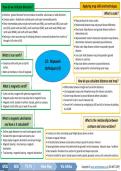Summary
Summary Grade 12 Geography Summaries Skills & Techniques plus Topic 1 & 2 (Term 1) - Via Afrika
- Course
- Institution
Grade 12 Geography Summaries Topic 1 & 2 (Term 1). This summaries are composed using and combining the Via Afrika textbooks' work with examples and supplementary notes. This product also contains the summaries for Geographic skills and Techniques (Terms 1 - 4). Contents: Geographical Skill...
[Show more]



